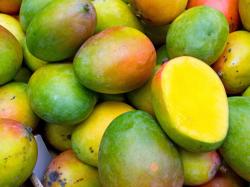National Mango Board Encourages A Ripe & Ready To Eat Mango Program
August 22, 2014 | 2 min to read

Orlando, Fla – The National Mango Board (NMB) is moving forward with its Ripe and Ready to Eat Mango Program (RRTEMP), a program aimed to provide U.S. consumers with a quality fruit that is ripe and ready to eat by the time of purchase. The NMB has done extensive research that shows that ripe fruit has higher acceptance rates within consumers.
The RRTEMP gives mangos a marketing advantage, eliminating the obstacle of consumers purchasing fruit short of its desired ripeness level, thus providing high quality fruit. To identify a high quality eating mango, the NMB has developed minimum maturity indices, proper fruit ripening protocols and fruit sensory descriptions to attract and satisfy consumers. Proper mango temperature management is one of the most important elements in order to have a quality ripe fruit that is ready for consumers to enjoy.
“Appropriate temperature management is an important component to improve consumers’ mango eating experience and knowing the opportunities of improvement is beneficial to the industry. Consumers continue to tell us they do not know when a mango is ripe,” said NMB Executive Director William Watson. “Our mango ripening program is designed to provide tools for the industry to consider if they want to develop their own ripening system. We have seen considerable growth of many other commodities that have been packed and shipped through a ripening program. There is still much more research to do but feel we are on the right path.”
After extensive research, the NMB in conjunction with the University of California Davis (Department of Plant Science), the University of Florida (IFAS Center for Food and Distribution and Retailing), Universidad del Valle in Guatemala and INIFAP in Mexico, developed a Mango Handling and Ripening Protocol. The Mango Handling and Ripening Protocol is designed to help improve mango handling practices in the U.S., leading to better quality mangos, greater consumer acceptance and higher mango sales. Topics covered in the protocol include; Mango Maturity and Ripeness, Mango Temperature Management, Mango Storage and Transportation, and Mango Handling and Merchandising at the Store.
The NMB hosted a Mango Ripening Webinar on August 20, 2014, that expanded in detail each of the topics covered on the Mango Handling and Ripening Protocol. Speakers included Dennis Kihlstadius from Produce Technical Services and Wendy McManus, Retail Program Manager at the NMB. During the webinar, the experts provided best practices and recommendations for stores and distribution centers that included improving temperature management at all distribution levels during transportation and storage, as well as mango displays at store level.
For more information on mango handling best practices, visit mango.org/retail/best-practices. For a copy of the mango Handling and Ripening Protocol, visit mango.org/industry/production-and-post-harvest-practices. The Mango Ripening Webinar is also available to view at mango.org/retail/best-practices.
About National Mango Board
The National Mango Board is an agriculture promotion group, which is supported by assessments from both domestic and imported mangos. The board was designed to drive awareness and consumption of fresh mangos in the U.S. The superfruit mango contains 100 calories, an excellent source of vitamins A and C, a good source of fiber and an amazing source of tropical flavor.
Mango availability per capita has increased 53 percent since 2005 to an estimated 2.87 pounds per year in 2013. Mango import volume for 2013 was 935 million pounds. Learn more at www.mango.org.
Source: National Mango Board
